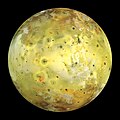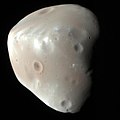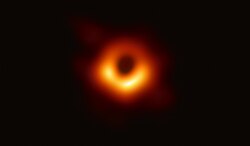Tidal circularization is an effect of the tidal forces between a body in orbit around a central celestial object, whereby the eccentricity of the orbit...
6 KB (863 words) - 13:55, 3 January 2025
trap (geology) Tidal circularization Longhitano, Sergio G.; Mellere, Donatella; Steel, Ronald J.; Ainsworth, R. Bruce (April 9, 2012). "Tidal depositional...
3 KB (255 words) - 17:29, 10 March 2025
orbit (tidal circularization) and the rotational periods of the two bodies adjust towards matching the orbital period (tidal locking). Sustained tidal heating...
10 KB (1,240 words) - 14:46, 12 March 2025
Planetary migration (section Tidal migration)
"Formation of Hot Planets by a Combination of Planet Scattering, Tidal Circularization, and the Kozai Mechanism". The Astrophysical Journal. 678 (1): 498–508...
40 KB (5,112 words) - 22:54, 19 December 2024
orbits, i.e. very low eccentricity. That is thought to be due to tidal circularization: reduction of eccentricity over time due to gravitational interaction...
56 KB (6,536 words) - 14:19, 20 April 2025
collisions with other bodies, gravitational perturbations, slow tidal circularization, or an origin as a collisionally-ejected fragment of Quaoar. Uncertainties...
20 KB (1,743 words) - 07:01, 25 March 2025
increase a moon's inclination, tidal effects work to eventually decrease it back to a coplanar state. Likewise, tidal circularization acts to decrease the eccentricity...
40 KB (3,939 words) - 22:47, 4 February 2025
Capture of Triton (section Tidal heating)
of tidal heating decreases during the circularization process, an ice shell grows atop the liquid water ocean, slowing the rate of cooling; tidal heating...
23 KB (2,701 words) - 02:17, 10 March 2025
Io (moon) (section Tidal heating)
this varying tidal pull, which, without the resonant orbit, would have gone into circularizing Io's orbit instead, creates significant tidal heating within...
116 KB (12,753 words) - 02:09, 11 May 2025
orbit is also slightly eccentric, which is surprising given the tidal circularization timescale of below 650 million years. The measured temperature on...
5 KB (305 words) - 16:04, 14 February 2025
from its birth orbit to orbit with a periastron just above the tidal circularization distance. Kepler-1704b is much more massive than Jupiter, at 4.51...
5 KB (379 words) - 18:27, 21 March 2025
Orbital decay (section Tidal effects)
orbit can also decay by negative tidal acceleration when the orbiting body is large enough to raise a significant tidal bulge on the body it is orbiting...
14 KB (1,984 words) - 20:35, 23 February 2025
Natural satellite (section Tidal locking)
its planet. This phenomenon comes about through a loss of energy due to tidal forces raised by the planet, slowing the rotation of the satellite until...
43 KB (3,564 words) - 16:01, 3 May 2025
of tidal interaction models. The expected tidal circularization and inspiral time for the system, depending on the choice of the values for the tidal quality...
12 KB (965 words) - 17:44, 4 February 2025
about one week. Most hot Jupiters are thought to have undergone tidal circularization, making the eccentricity of HD 185269 b (e=0.3) unusual. Despite...
4 KB (317 words) - 02:14, 28 November 2023
system. Over time, the mutual tidal interaction of the pair may lead to rotational synchronization and orbit circularization. Spica is a polarimetric variable...
27 KB (2,492 words) - 13:58, 9 May 2025
a rubble pile held together by a thin crust that is being torn apart by tidal interactions. Phobos gets closer to Mars by about 2 centimetres (0.79 in)...
73 KB (7,414 words) - 08:38, 23 April 2025
an intrinsically eccentric orbit or by slow tidal evolution, in which the time for its orbit to circularize is comparable to the age of the Solar System...
18 KB (1,426 words) - 02:30, 11 May 2025
interior. This source of internal heat disappeared following tidal locking and circularization of the orbit. Two types of mechanisms have been proposed for...
80 KB (7,951 words) - 02:22, 11 May 2025
from the asteroid belt, with orbits that have been circularized either by atmospheric drag or tidal forces, as capture requires dissipation of energy....
30 KB (2,842 words) - 08:11, 9 April 2025
encounter with another massive planet, followed by the circularization and shrinking of the orbits due to tidal interactions with the star. A hot Jupiter's orbit...
43 KB (5,067 words) - 18:27, 18 April 2025
Exoplanet (section Tidal heating)
planets near the star; thus, 85% of the exoplanets detected are inside the tidal locking zone. In several cases, multiple planets have been observed around...
157 KB (16,883 words) - 20:40, 30 April 2025
eccentricity is measured to be lower than 0.29 to a 90% confidence. The circularization of the orbit cannot be explained by stellar tides, and thus the circularity...
15 KB (1,630 words) - 06:55, 25 December 2024
eccentricity and prevents tidal dissipation within Io from circularizing its orbit. The eccentricity leads to vertical differences in Io's tidal bulge of as much...
56 KB (6,290 words) - 18:38, 10 May 2025
moons are tidally locked, always presenting the same face towards Mars. Since Phobos orbits Mars faster than the planet itself rotates, tidal forces are...
44 KB (4,642 words) - 00:48, 28 April 2025
orbits with a perihelion near the star followed by the circularization of its orbit due to tidal interactions with the star can leave a planet on a close...
75 KB (9,180 words) - 01:06, 29 December 2024
enough tidal evolution to circularize their orbits, which is consistent with the low measured eccentricity, but that the primary need not be tidally locked...
7 KB (606 words) - 02:36, 11 May 2025
(3.11 million km). At this distance from the star, tidal interactions should in theory circularize the orbit; however, measurements reveal that it has...
13 KB (1,210 words) - 08:02, 17 September 2024
classifications. First, the tidal forces in the vicinity of the event horizon are significantly weaker for supermassive black holes. The tidal force on a body at...
106 KB (11,103 words) - 12:48, 24 April 2025
the same point in every orbit it makes. The tidal force from Jupiter, on the other hand, works to circularize their orbits. The eccentricity of their orbits...
173 KB (16,489 words) - 16:09, 10 May 2025






















